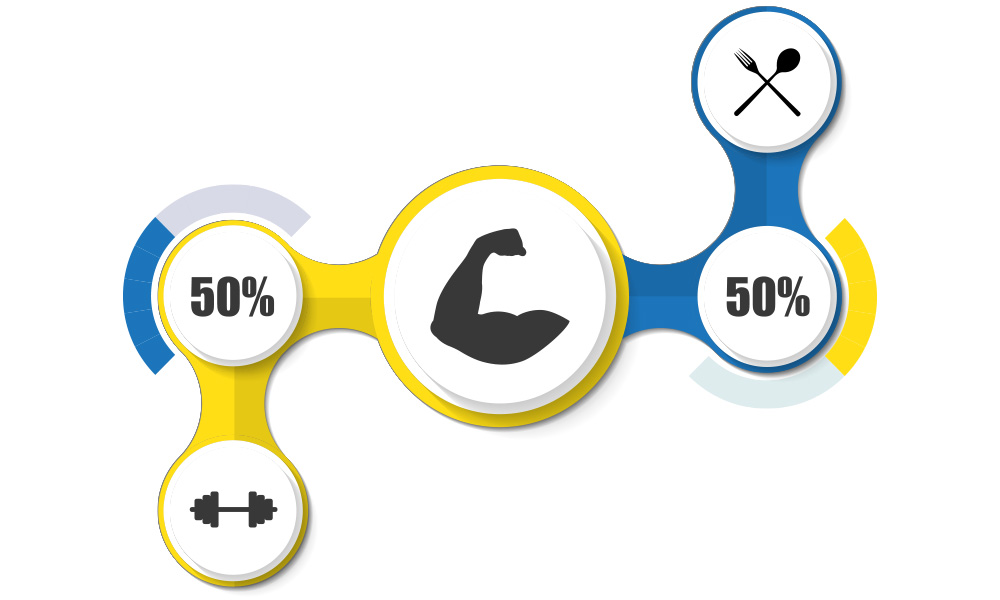
In a previous blog post, we explored which foods are best to help endurance athletes improve their performance and achieve the ideal balance between exercise and fitness nutrition. Since some of you don’t just do endurance sports, in this article we look at the best foods for athletes doing weight training. We also reveal how much you should eat and when.
Eat yourself fit for your weight training
With weight training, the main focus is on building muscle. Some people want to be more muscular, while others just want to tone their body and achieve a more streamlined physique. With weight training, too, exercise and diet are inextricably linked. Roughly 50% of an individual’s success is down to diet. Only with the right fitness nutrition will you be able to build muscle mass and achieve your personal goals.
When it comes to fitness nutrition for weight training, protein is particularly important. Muscles need protein not only to grow, but also for the crucial role it plays in muscle regeneration. Weight training leads to small tears – known as “micro-tears” – in the muscles, which the body must then repair. As a result, strength athletes need approximately 20-25% more protein than endurance athletes. However, it is also vital that strength athletes get enough carbohydrates.
Fitness nutrition – Before your workout
Strength athletes must make sure they get enough carbohydrates, particularly before a training session. This is the only way to ensure the body’s glycogen stores are at a sufficient level to be able to provide the energy required during training. Protein must form part of your pre-workout fitness nutrition plan, too, as the right amount of protein will mean that vital amino acids are released during the workout, helping to enable the formation of muscle protein and thus boosting muscle growth during the training session itself.
The correct carbohydrates to eat before weight training are long-chain carbohydrates. These include potatoes, rice, oats, and pasta – preferably wholegrain pasta, of course.
Good sources of protein include turkey, chicken, nuts, tuna fish, or lentils and beans.
Some people are able to eat a meal just an hour before a training session, while others are not able to stomach anything. The best thing to do is work out for yourself how long before a training session you can eat. Start out by trying two or three hours before a workout. If you still have an unpleasant feeling of fullness during your workout, then you need to eat earlier. On the other hand, if you feel like you don’t have enough energy, then you should leave a shorter gap between eating and working out.

Fitness nutrition – After your workout
For strength athletes, the meal after a training session is the most important meal of all, because muscle growth does not begin until after a workout. The body’s energy stores are empty following physical exertion and because of this it is important to refuel quickly after a training session. So-called short-chain carbohydrates, which the body is able to absorb and convert quickly, are good for this. Fruit for example provides these kinds of carbohydrates. However, because the body burns these carbohydrates very quickly, it is important to eat a full meal about one or two hours after a training session. This meal must contain both long-chain carbohydrates and adequate amounts of protein. Long-chain carbohydrates supply the body with energy for considerably longer than short-chain carbohydrates.
Sources of long-chain – or good – carbohydrates include:
- potatoes
- rice
- pasta
- sweet potatoes
- quinoa
- fruit (e.g. bananas or kiwi)
To satisfy the body’s need for protein after a workout, the carbohydrates above should be combined with the following sources of protein:
- cottage cheese
- salmon
- tuna fish
- chicken
- yogurt
- eggs
There are, of course, many other foods that can provide the body with the nutrients it needs after a weight training session. That said, the foods listed here can be used to create a multitude of dishes that are anything but dull. For example, strength athletes can enjoy a meal of chicken breast with vegetables or rice after a workout, or salmon fillet with rice. There are countless different options, making a strength athlete’s diet anything but monotonous.
In total, athletes focusing on weight training should eat foods in the following ratios:
- Carbohydrates: 45-55%
- Protein: 20-25%
- Fats: 20-25%
General tips for fitness nutrition for weight training
- Rather than eating two or three big meals a day, eat several small meals instead. If your last meal was three or four hours ago, your body may enter a catabolic (muscle-depleting) state. This is far from ideal for effective training.
- It is therefore best to have 4 to 6 meals roughly two-and-a-half to three hours apart
- For your full meal following a training session, you should make sure you have a good ratio of carbohydrates and protein. Strength athletes should use the following quantities as a guide: The meal after your weight training session should include 1 to 1.5 grams of carbohydrates and 0,4 grams of protein per kg of body weight.
- In addition to protein and carbohydrates, fats are also essential for building muscle. It is important to make sure you eat good fats, too. So-called mono- and polyunsaturated fats are part of a healthy fitness diet.
It is also vital to drink plenty when weight training. You can even reach for your water bottle between individual training exercises. Athletes should always drink plenty, but at least two to two and a half litres every day.
Fitness nutrition accounts for about 50% of successful training. So you should pay just as much attention to your diet as to your training plan. Eat yourself fit 😉